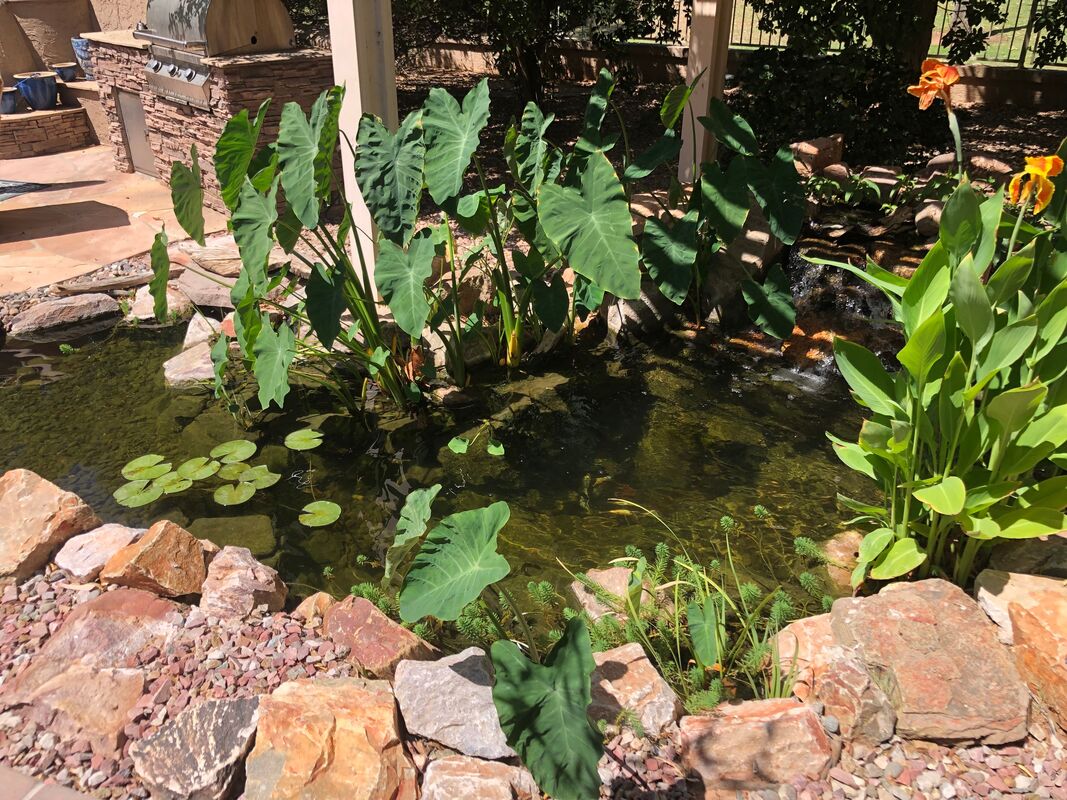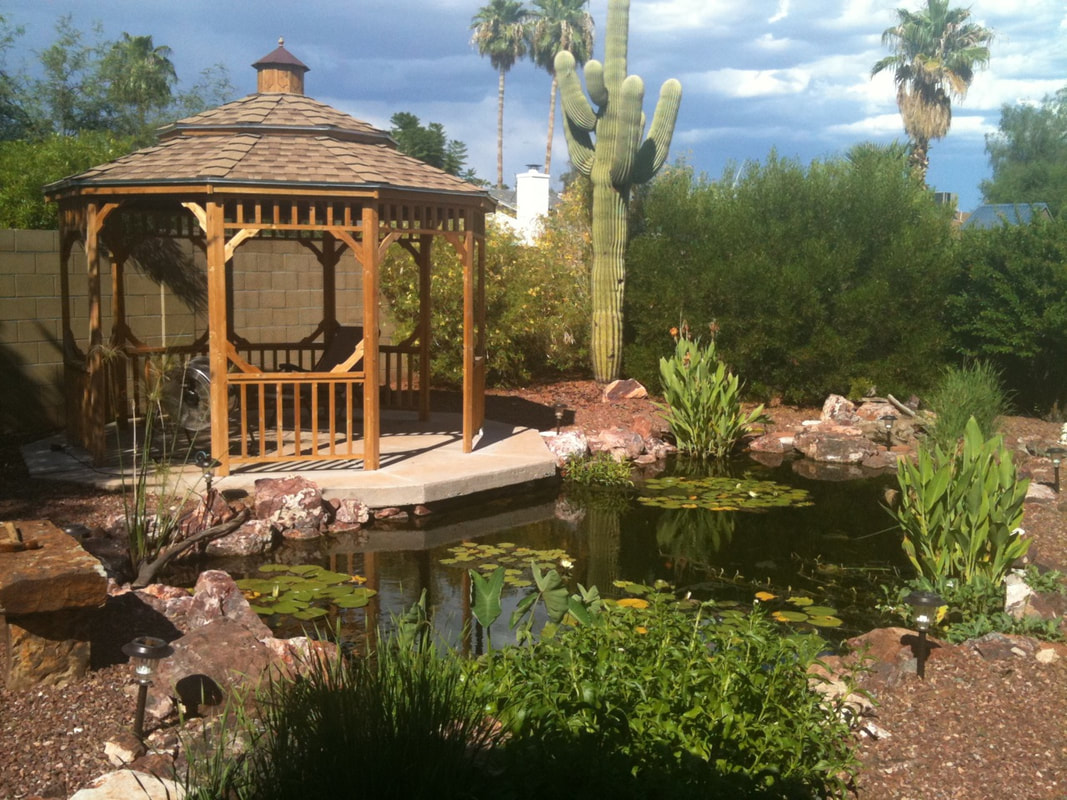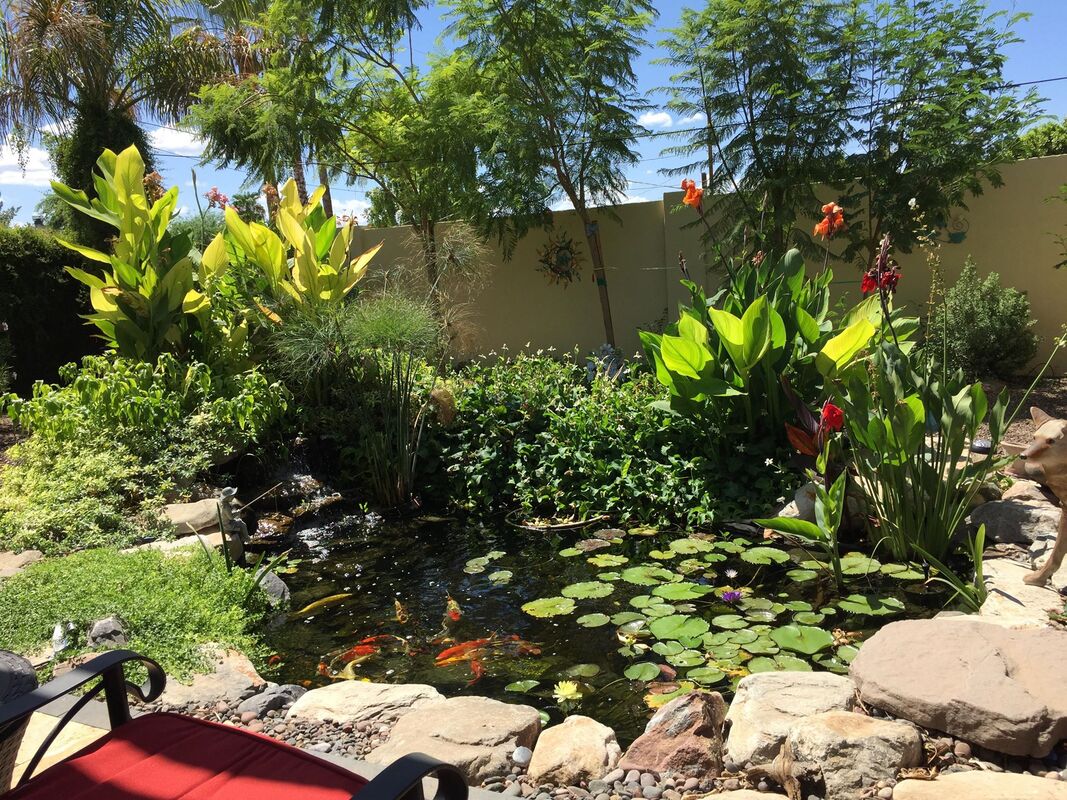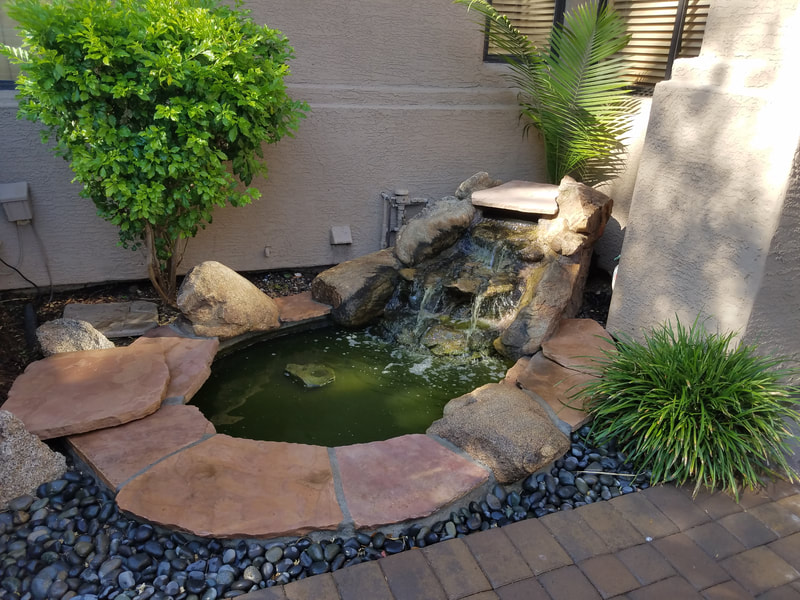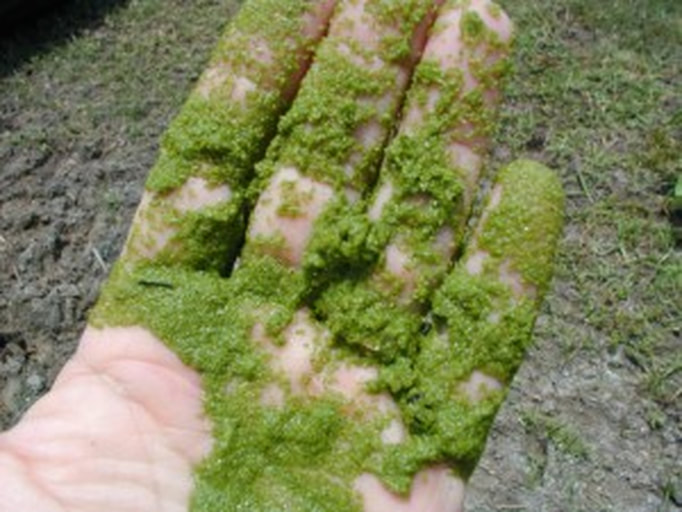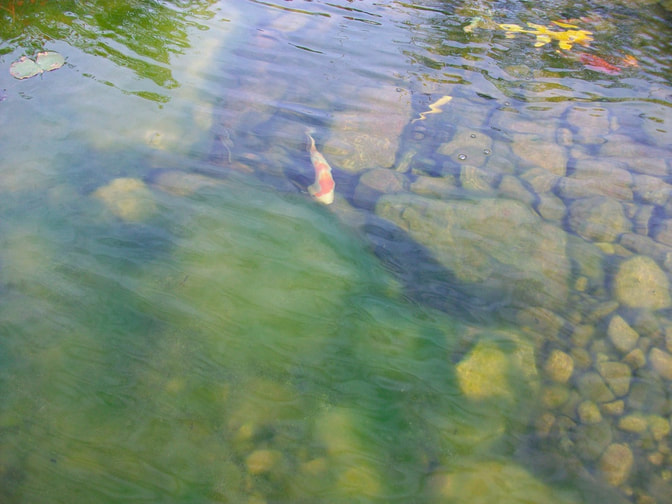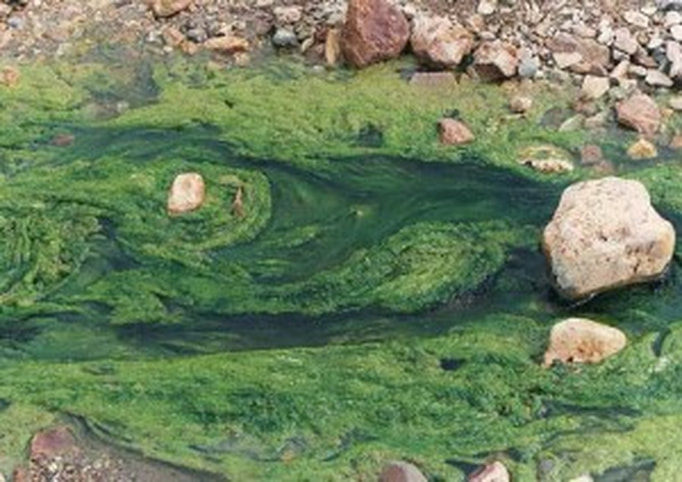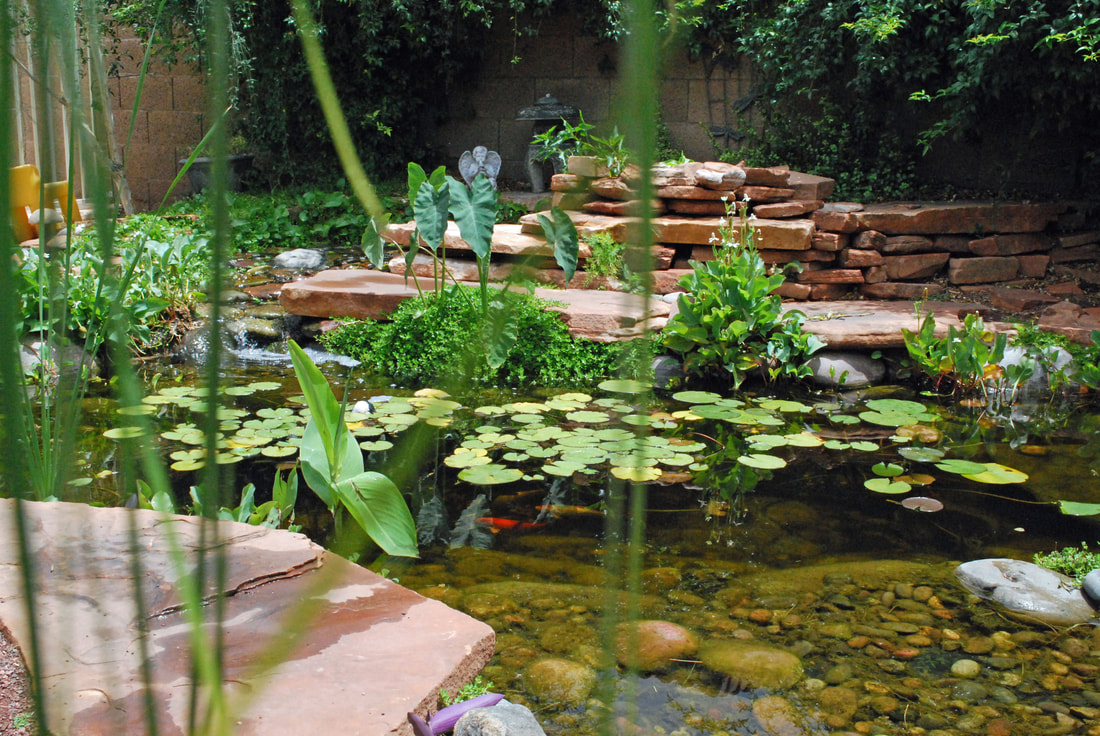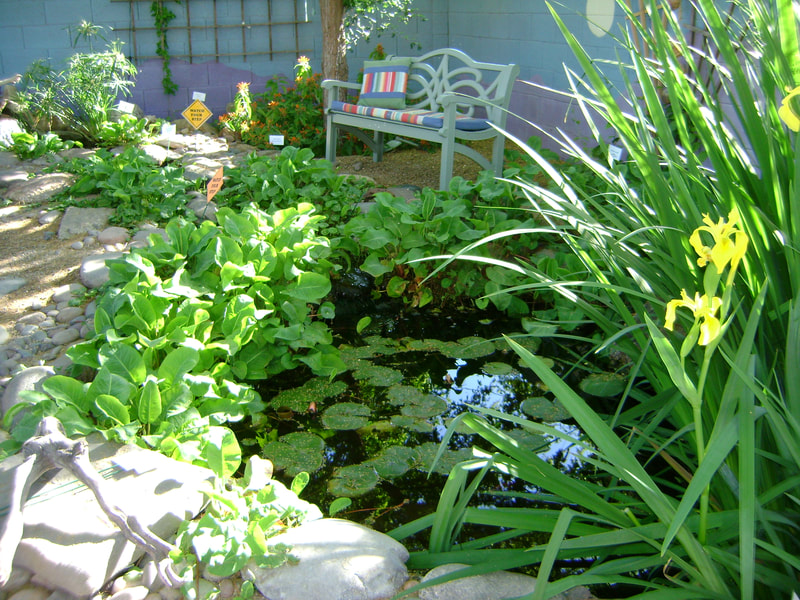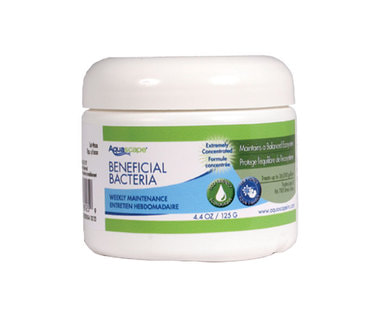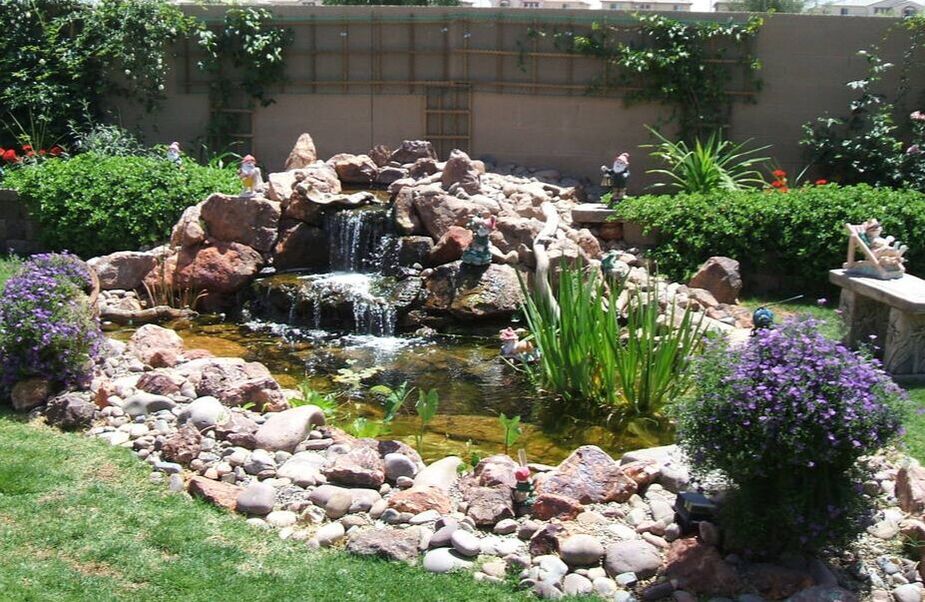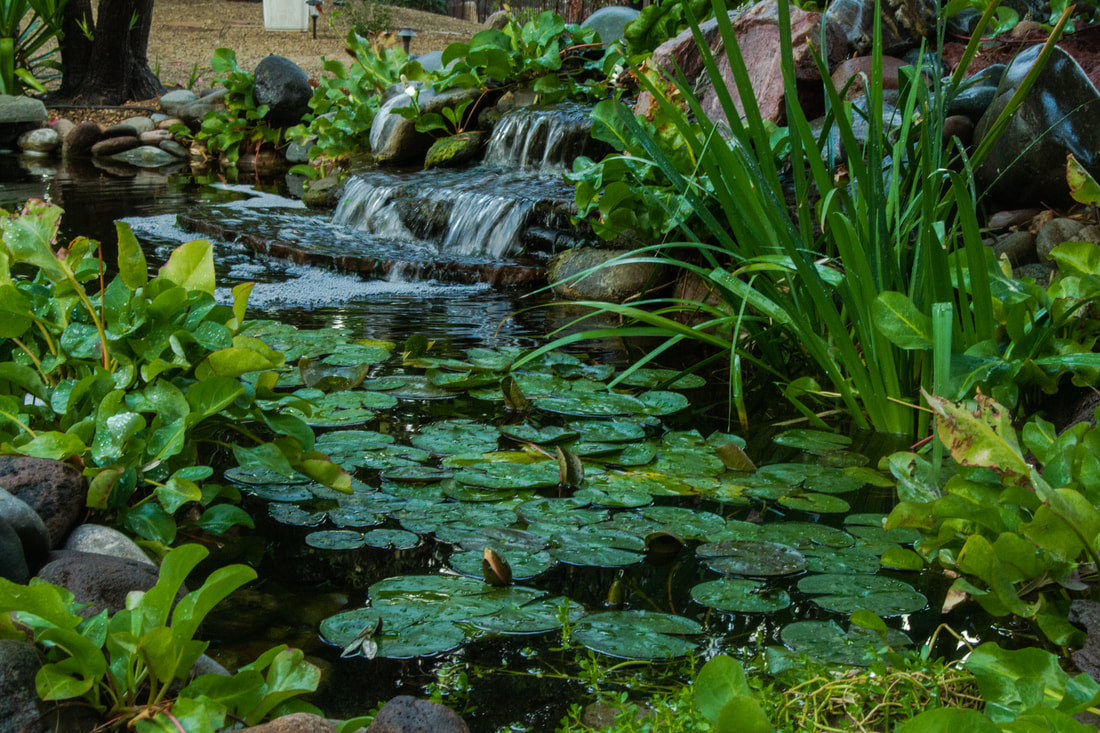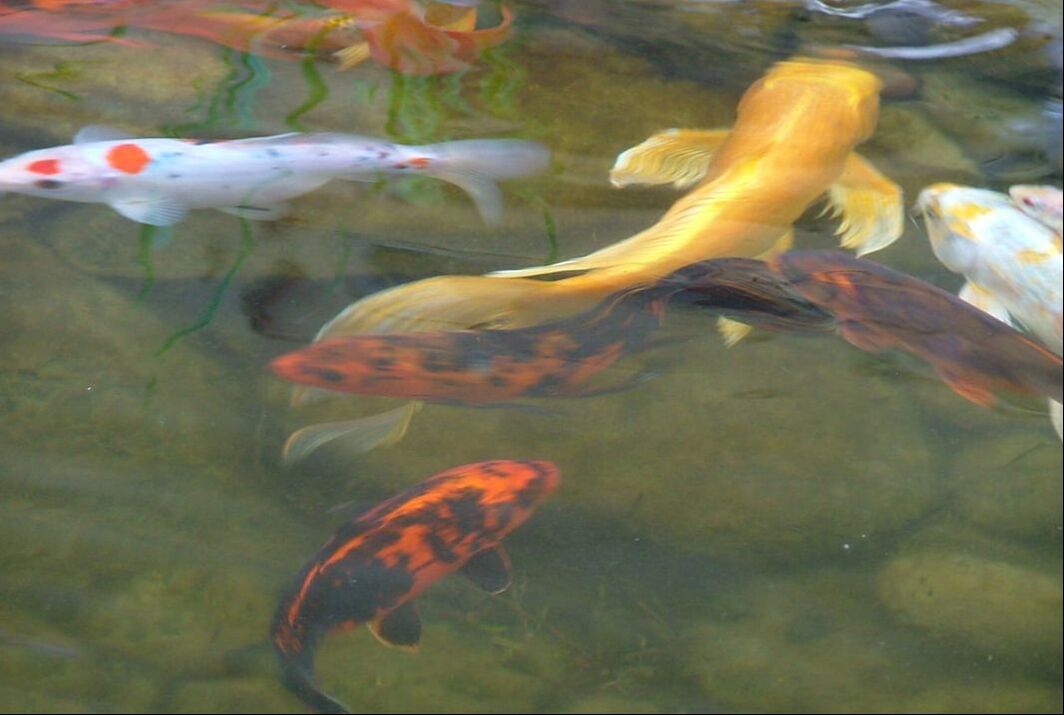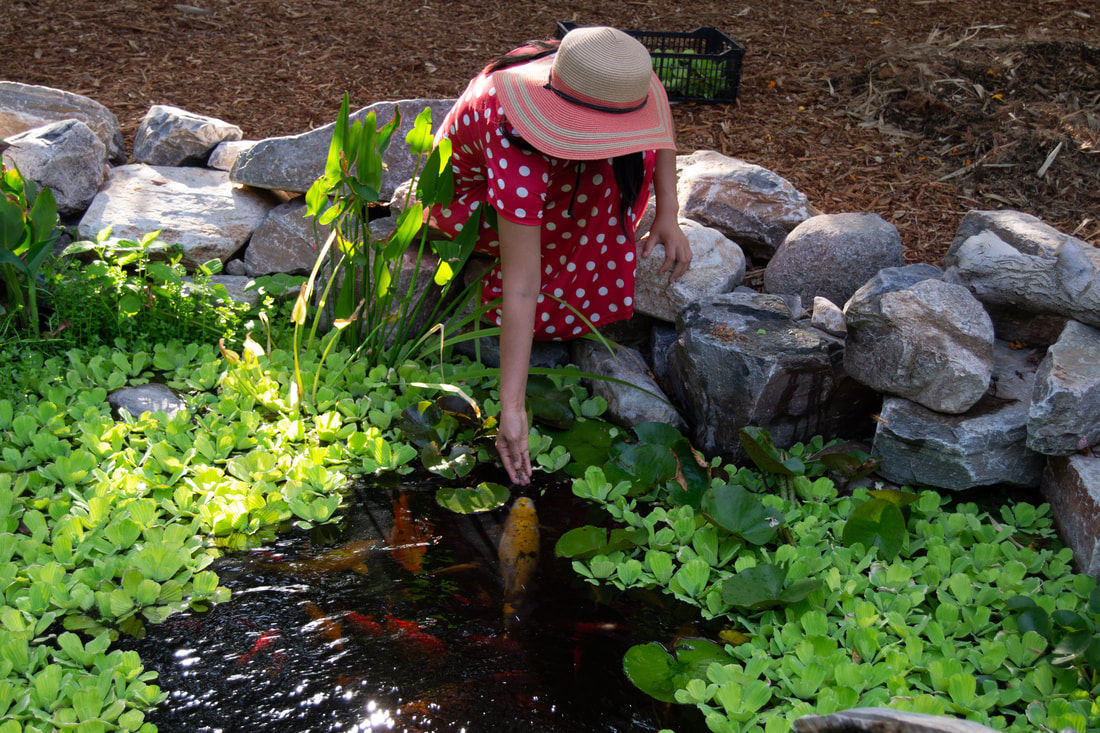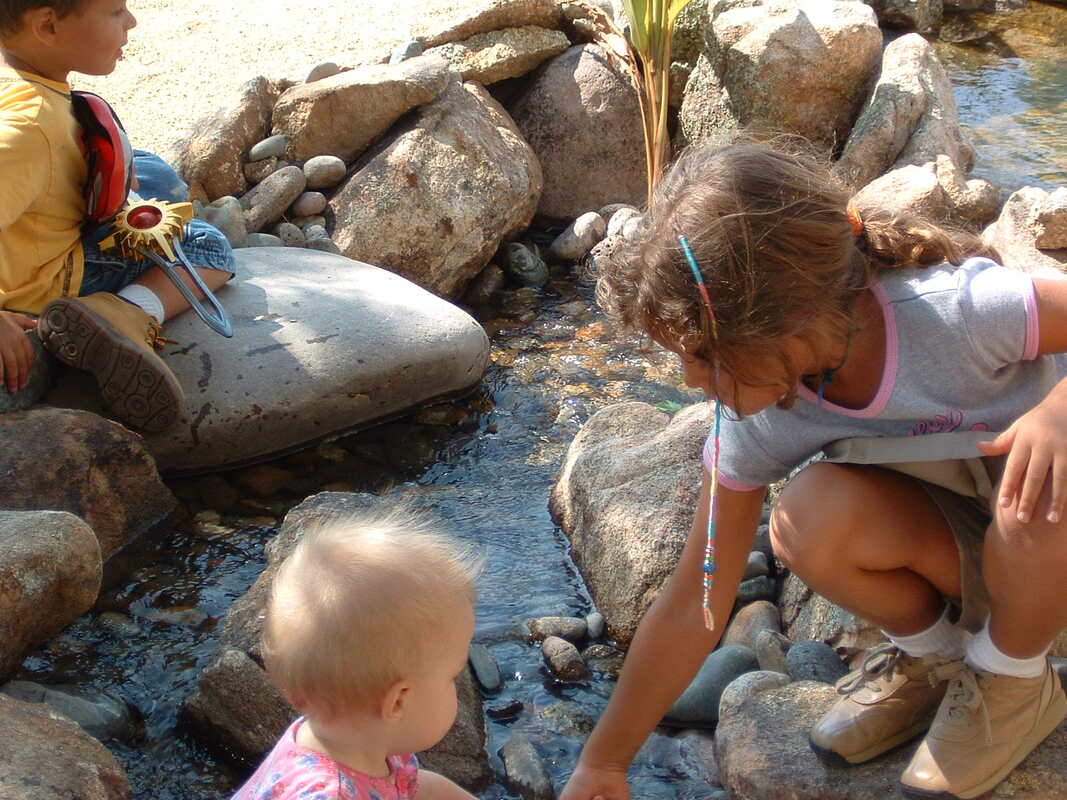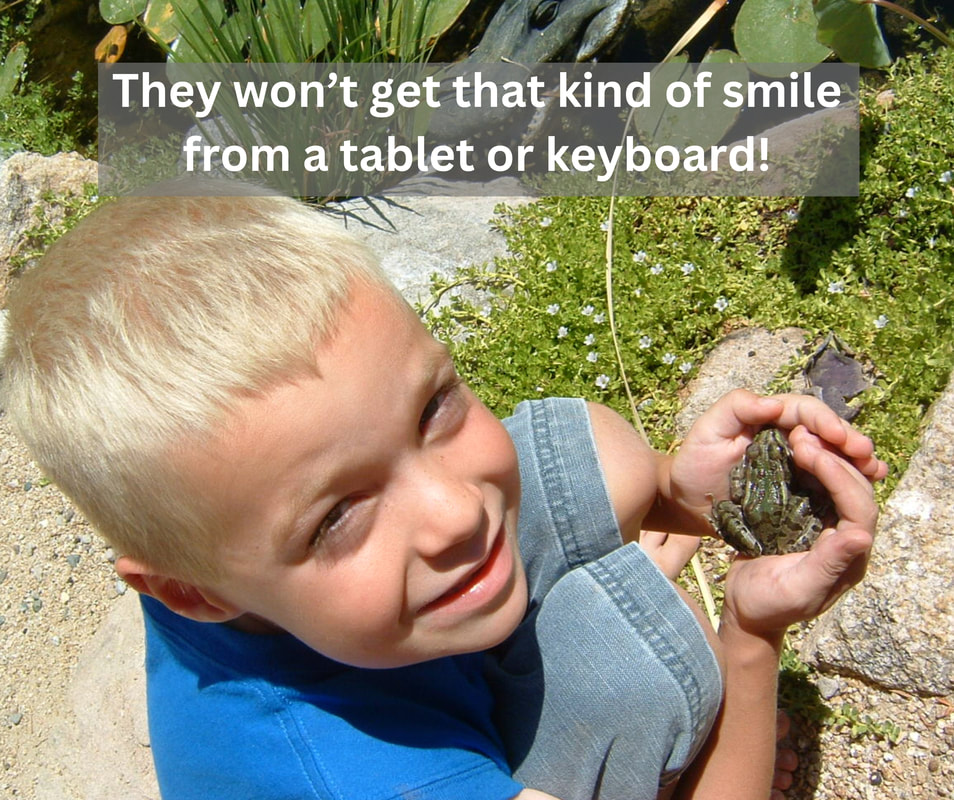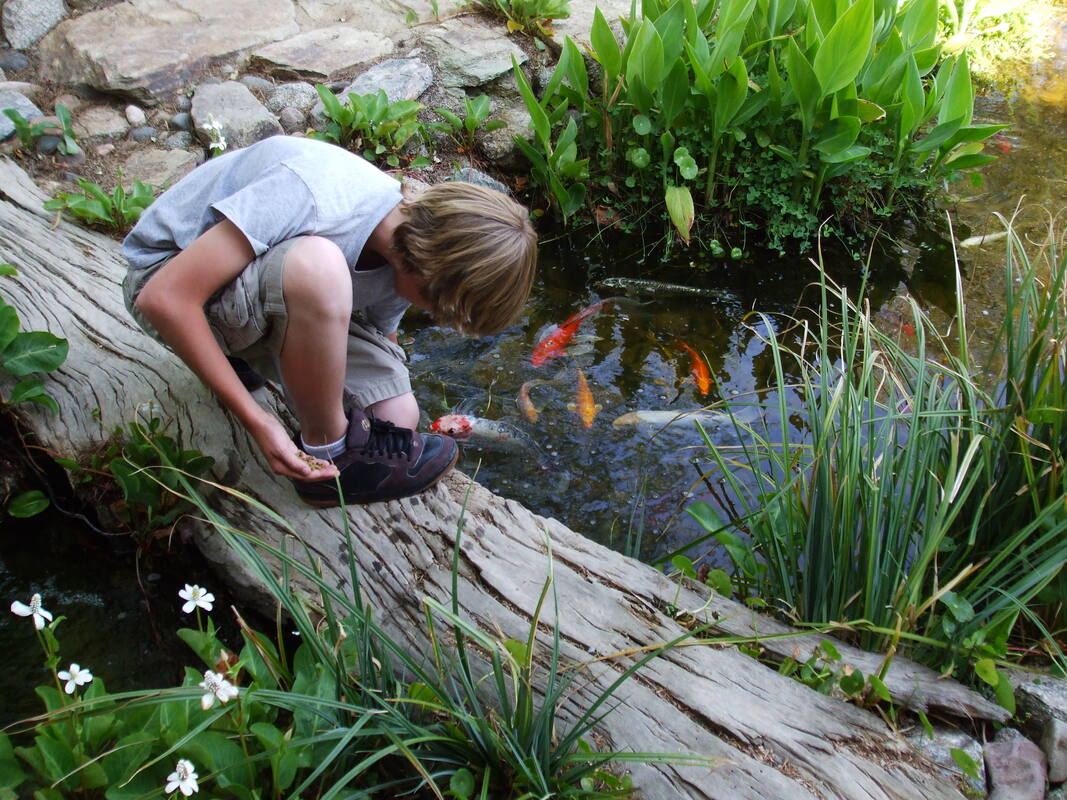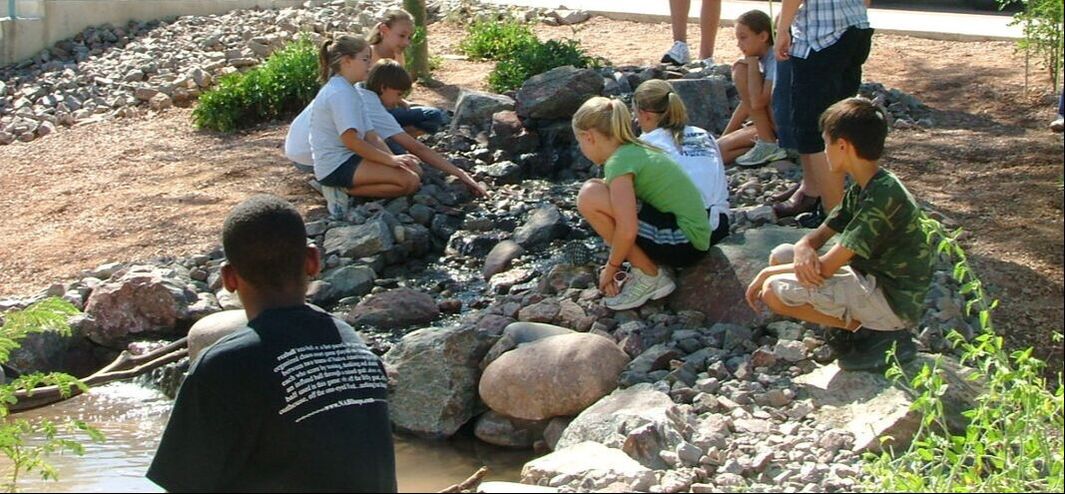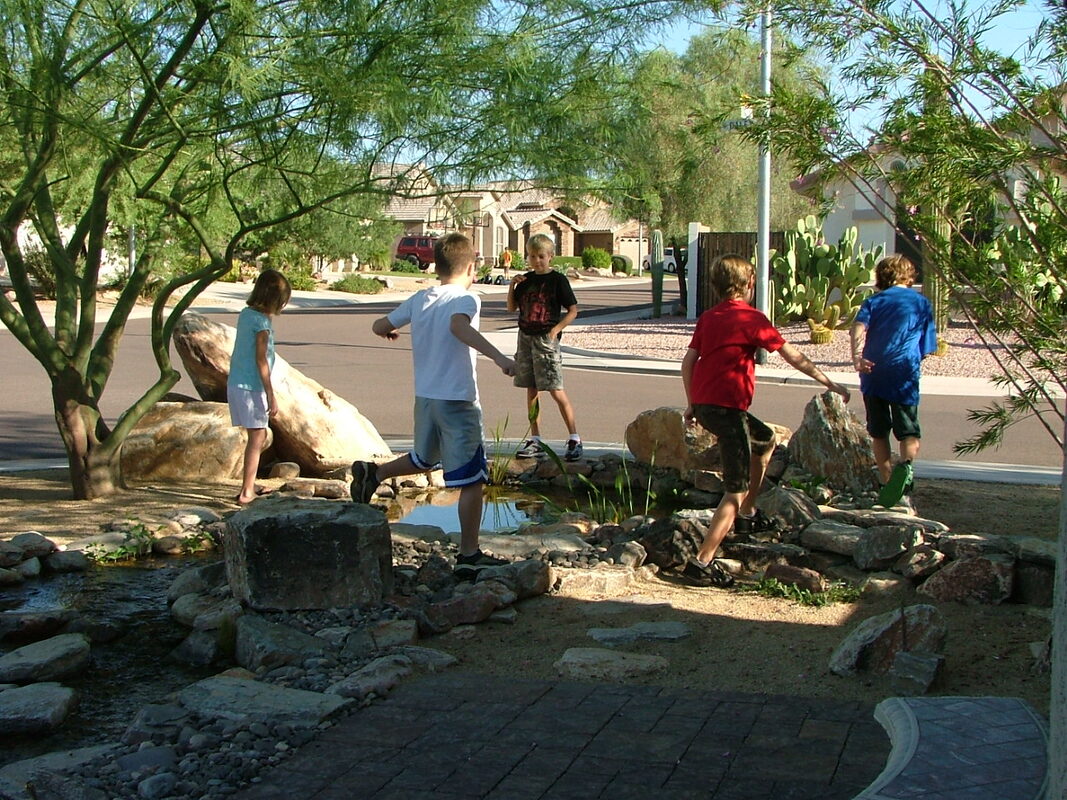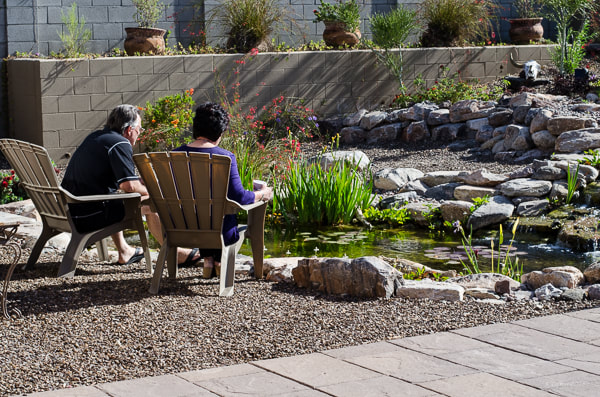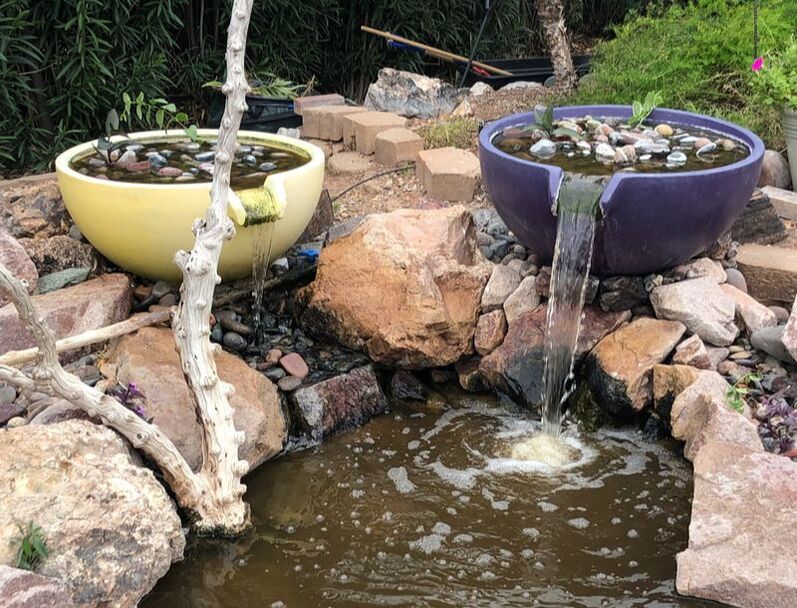What to Expect When You're Expecting -- a Phoenix Ecosystem Pond! Welcome to the world of organic water gardening! Unlike lawns and pools, ecosystem ponds in Phoenix are not as common knowledge for most of us. Very few Phoenix natives or early transplants grew up with a backyard pond or knew anyone who had one. And if we did, it’s unlikely that they were practicing organic water gardening specifically. But why go through the trouble of creating an ecosystem versus just tossing in some chemicals and getting instant results? For one thing, ecosystems are Earth-friendly. There is life and nature in an organic pond, and life will visit that organic water. Isn't there enough chemicals and concrete covering our planet already? Wouldn't you like to feel good about choosing this home improvement option? So, an ecosystem water feature adds beauty to your yard, gives you hours upon hours of entertainment and viewing pleasure, AND you get to feel good about the choice. Oh, and if you have pets, they can safely drink the water - bonus! The Process of Creating an EcosystemBasically, we are working with the same processes in a new water feature as are used in organic vegetable gardening, and even hydroponics systems. Well cared for and properly maintained your feature will provide decades of beautiful, low maintenance, entertainment, and viewing pleasure.  Maybe think of the new feature as a new puppy. “Pond chemicals” (i.e., algaecide) are akin to a rolled-up newspaper or a swift kick. That’s no way to train a new pet! With patience, and proper positive reinforcement, an organic water feature, like a puppy, will develop into a cherished and well-behaved individual. The key is patience, along with using natural products like beneficial bacteria and enzymes, encouraging the "good-guys," and having the right balance of plants, rocks, and fish. This combination creates a closed ecosystem that can be managed easily. Our philosophy has always been KISS: keep it simple, silly! An Ecosystem IS WORTH THE TIME & PATIENCE IN THE LONG RUNBut here’s what happens right away as the ecosystem in a living water feature is brought to life. Like a new garden, we prepare the foundation: building with natural rocks (to support the zooplankton life), and adding aquatic plants, fish, and beneficial bacteria (just like good soil, amendments, and plant starts in a garden). You also need to keep the “weeds” at bay, which in an organic water feature means string algae. Once the aquatic plants get established and start growing aggressively, the algae, like weeds in a healthy garden, will be choked out for the most part. Remember that there will always be green fuzz on the rocks – this is not a pool or spa with sterile water. That green fuzz actually serves as another filter to produce crystal-clear water (we call it the pond patina). The process of bringing a living water feature to life takes a bit of time and patience. It may take a bit longer, or it may happen quicker, depending on many factors, including the weather. Each water feature is an individual and will balance when it’s darn good and ready. But we promise you that this WILL happen as long as no one tries to “help” things along adding chemical treatments and "quick fixes." Once you add chemicals to your pond, it perpetuates that process and becomes a chemically-dependent water feature. Pond Ecosystem in a NutshellHere are the key ingredients to a healthy, natural-looking ecosystem pond that remains low-maintenance:
OTHER POSTS YOU MIGHT ENJOY: WHAT IS ALGAE?Algae (Life Sciences & Allied Applications / Biology): unicellular or multi-cellular organisms formerly classified as plants, occurring in fresh or salt water or moist ground, that have chlorophyll and other pigments but lack true stems, roots, and leaves. Algae, which are now regarded as protoctists, include the seaweeds, diatoms, and spirogyra. [from Latin, plural of alga seaweed, of uncertain origin]. What can I do about the algae in my Phoenix Pond? Well, okay, but not everybody is excited about its presence in their backyard pond, right? If you have a living pond, with plants and fish, algae is going to insist on being a part of your ecosystem, especially in the “winter” months here in Phoenix when the other plants are dormant. The fact of the matter is, when the growth rate of algae is controlled, algae is a beneficial part of your ecosystem and helps maintain healthy water quality through several functions:
In all seriousness, we know it can grow out of control and make our ponds and streams unsightly. Once it starts growing beyond just fuzzy rocks (we call it pond patina) and becomes more of a filamentatious algae that exceeds a couple of inches in length, many people prefer to take action to stop its growth. Of course, once your plants start growing aggressively, they’ll take a lot of the nutrients in the water and effectively starve out the algae into submission. However, there are a couple of more aggressive methods of ridding yourself of this aquatic weed. The cheapest method is to simply hand-weed it out and use it. That’s right, it has uses: you can compost it or even use it directly as a natural mulch around plants such as roses. It’s very nutrient-rich. If you don’t want to hand-weed it, you can use a water treatment product to break it up, or starve it out — just make sure you clean your skimmer basket often during this process! Can I just use an Algaecide in my Phoenix Pond? PLEASE don’t run out to the pet store or pool supply and buy an algaecide! This chemical will indeed kill the algae, which seems like a good idea at the time, but what happens is that it dies and sinks to the bottom of your pond. Now, what do you suppose happens to dead plant material on the bottom of your pond? It becomes food for more algae and other, less desirable anaerobic processes that fowl your pond water. Once you resort to chemistry to control your algae problem, chemistry will become more of a hobby than the water gardening, and you’ve created a chemically-dependent water feature. So you must ask yourself….Did I get into this hobby for the love of aquatic plants, amphibians, dragonflies, and fish?……or for the love of practicing water chemistry? In summary, algae is a fact of life in the world of ponding. It's part of the ecosystem. If this is not something that you wish to deal with, then a non-living system is going to be more to your liking. The more you know... MORE POSTS YOU MIGHT ENJOY: Are you considering building a pond? How tough can it really be, right? If you're going to do it yourself, here are 10 common mistakes that you can avoid with a little preparation. Remember: Proper Preparation Prevents Piss-Poor Performance. Poor LocationStarting with the design of the pond, Phoenix homeowners too often place their DIY pond in an unused area of the property or in a low spot that collects water. Both of these locations cause problems. Unused areas of the landscape are unused for a reason and it's a waste to put a key focal-point feature in an area that won't be seen regularly. Out of sight, out of mind … meaning nobody will care for it. Low spots that collect water are challenging to build in (high water table) and water quality can suffer from too much runoff and pollutants entering the pond system. Rainwater harvesting and stormwater management in Phoenix are completely separate conversations from a simple fish pond. Underestimating LaborUnderestimating the amount of physical work involved with a pond installation is very common. As professional pond contractors, we are regularly asked to complete ponds in Phoenix that are partially excavated by a homeowner. Unless you dig for a living, it's tougher than you think! Proper pond excavation is something that needs to be thought out carefully to provide shelves and pockets for plants. If you just dig a hole and slap some rubber or plastic down, it's technically a pond, but you may not like the ramifications of doing it that way. Creating Steep SidesAnd speaking of excavation, digging a deep bowl with no provisions for shallow areas makes stacking stones on the inside of the pond in Phoenix very difficult. And they won't stay put, either. The stacking would be unstable and since there aren’t shallow areas, it is difficult and dangerous to get in and out of the pond for maintenance. Plus, there's no place or ledges for aquatic plants, the majority of which grow in less than 12" of water, even in Phoenix. Too ShallowA shallow pond in Phoenix is obviously easier to dig than a deeper one, but if it’s not deep enough, the fish won’t be able to over-winter in the northern part of Arizona. And if you live in the central or southern area, your pond won’t stay cool if it’s too shallow. Fish don’t like hot ponds in Phoenix! 18" is the least amount of finished depth (after the rocks and gravel have been installed) that you want in Phoenix, and that's for goldfish. Koi need a bit more elbow room, and we recommend 24" minimum depth. Lack of LedgesA common mistake is when the pond is excavated in a bowl fashion, with gently sloping sides that get deeper towards the middle. This is difficult to disguise with rock since gravel will slide towards the deep area and boulders take up too much room. This will cause an unstable build and is a recipe for disaster and potential injury when maintaining the pond. Improper Use of Rock and StoneAn installed pond in Phoenix is enhanced with rock to give it a desirable natural-looking appearance; a typical feature will use several tons of stone. That can be a lot of wear and tear on the family minivan, and it needs to be moved and stacked properly for stability. Many do-it-yourselfers will decide this is too much work and they'll choose small, manageable stones that are easy to move and stack. While the work might be easier, this results in the pond falling short of aesthetics. Also, the pond loses the structural stability provided by the larger, more difficult-to-move boulders. In some cases, the novice pond installer will just eliminate the stonework altogether, which then eliminates the natural-looking feel that was the goal at the onset of the project. Without rock and gravel, the system fails to function properly because stone not only lends to the aesthetics of the feature, but also functions as a habitat for colonization by a variety of beneficial organisms from bacteria to crustaceans… all critical to the success of a natural-looking, organic ecosystem pond. Too SmallAgain, a small pond is easier to construct (less digging and rock placement) but it’s actually harder to maintain. A small feature is less stable than a larger volume of water, and most people end up making the water garden larger later down the road because they not only love it but their plants and fish outgrow a small feature. And then you'll need to decide whether to simply live with what you've created with all that blood, sweat, and tears, or to do it all over again. Lack of Proper FiltrationConsumer thought is that real lakes, rivers, and streams function without pumps and filters, so why does their backyard pond need it? Well, that’s not even a close comparison because it’s completely different hydrology. Do-it-yourselfers sometimes purchase inadequate filters or will purchase components “a la carte.” It may be cheaper to purchase the items piecemeal, but it's challenging because different manufacturers use different fittings, and now you need to "McGuiver" things to work together, versus having everything designed to work as a unit from the get-go. Efficiency and simplicity will create a better system for your pond. Poor Access/Staging AreaBefore you get started, think about where to place your rock and gravel when it’s delivered, or where you want to place the dirt during excavation. Poor planning can lead to having little to no room to get in and out of the property during the construction process, potential tripping hazards, etc. Improper Berm Size for WaterfallsIf the mound or berm area for the waterfall is too small or too steep, then the waterfall will look out of place and more like a volcano than a waterfall. The berm and waterfall need to be scaled according to the size of the property and the feature. Many people want a big waterfall that looks and sounds great, but it can become difficult and expensive to build, and it can overpower the space you have set aside for your pond. The waterfall needs to fit with the property and lifestyle of the pond owner -- and, just as important, the pond needs to be large enough to contain the splash generated by the waterfall: splash width is two times the height of the fall. There are more tricks of the trade, of course, but we don't want to give away ALL of our secrets! MORE POSTS YOU MIGHT ENJOY:Did you know that fish possess body language? If you familiarize yourself with the good body language in fish, you’ll be able to also recognize bad fish body language. Then you’ll be able to diagnose and treat your fish before any illness or situation becomes too severe. Let’s first take a look at good body language in your pond fish:
Some examples of bad fish body language include:
Loss of appetiteWhen fish lose their appetite, numerous possibilities loom but without any additional symptoms, you could suspect some deterioration in water quality. In particular, warm water with low oxygen adversely affects fish appetites, which you’ll typically see during the hottest summer months. In ponds that are more than four feet deep and without water movement in the deeper areas, the oxygen levels sag, which can result in suffering fish. In either situation, adding an aerator to boost oxygen levels in the pond could be a simple fix. Fish may also lose their appetite if nitrogen is imbalanced. When the nitrate levels climb in established ponds, fish will lose their appetite. A quick water test will let you know if nitrate is to blame. If nitrate is ruled out, then it could be a parasite problem. You’ll also notice a loss in appetite when the pond water temperature falls below 68 degrees Fahrenheit, which is normal. Clamped finsWhen fish hold their fins close to their body, it’s a symptom of illness. Poor water quality and parasites are the likely culprits. Fish with clamped fins look like a fish with only a tail because all the other fins are pulled in close to the body. The fish may just rest on the bottom of the pond with its fins clamped. An assessment of water quality is the place to start. If nothing is found, the fish likely has a parasite that needs to be addressed (see how to identify and treat fish parasites). Resting on the bottomA common sign of illness is when the fish rests on the bottom of the pond. The most common cause of this bad fish body language is high water temperatures, high nitrates, and low oxygen levels. Parasites could also be the cause. Test the water, and if nothing is found, you’ve probably got a parasite issue. Laying on the bottomThis behavior is slightly different because the fish will lay on the bottom of the pond on its side. This is a sign of severe, life-threatening stress. Usually, very cold water is the cause of this bad body language. Water quality and overwhelming parasitism can also cause this. Stiff swimming with clamped finsStiff swimming is a serious sign in fish and almost always points to poor water quality, but the most common cause is parasitism, which is then swinging into a full-blown bacterial infection. Start by testing the water, and if nothing is found, a biopsy can be conducted to confirm the presence of parasites. You can also closely check the gills of your fish for signs of bacterial infection. Piping at the pond surfaceWhen fish are gasping at the surface of the pond, it’s highly illustrative of two things. Either the pond water doesn’t have enough oxygen in it, or the fish can’t get that oxygen because its gills are being wrecked by something. Adding an aerator typically alleviates this problem but if it doesn’t, you likely have a parasite problem. Less active or floating in waterLess activity isn’t necessarily a sign of illness, but you’ll want to keep some things in mind. Low oxygen levels can cause the fish to resist higher activity and foraging behaviors. This would be especially true if the listless less active fish are the larger ones whose oxygen demand is higher. Warm water carries less oxygen and if the pond is warm and there’s minimal water turnover from a waterfall or aerator, this could be a contributor. Adding a pond aerator will remedy this problem within four to six hours. If the fish becomes actively engaged again, you’ve solved the problem. If not, suspect the presence of a parasite. Flashing behaviorFlashing, or scratching, is bad body language when it’s common among your fish. It’s not uncommon to see a fish flash or scratch on the pond bottom of other submerged ornamentation. This isn’t considered a problem. However, if you see many fish scratching or flashing every hour, that would be bad body language and considered a problem. Flashing can be caused by several things, but your main suspects are the pH level of the pond or a parasite. Once you become familiar with good and bad body language in your pond fish, you’ll be better equipped to remedy any negative situation and provide them with a healthy, happy home. OTHER POSTS YOU MIGHT ENJOY: Nature has a way of captivating young minds with its wonders. Ecosystem ponds, teeming with life, provide a fantastic opportunity for children to connect with the natural world right in their own backyards or local parks. While observing and learning about fish, frogs, and plants are typical activities, there are unconventional and creative ways for children to engage with living ecosystem ponds that can spark their curiosity and foster a lifelong love for nature. In this blog, we'll explore some unique ideas to make the experience of interacting with a pond even more magical. SCREEN VS. NATUREKids won’t remember their best day in front of a TV, keyboard, or sitting through a lecture. Kids under 15 struggle to sit still in a classroom setting. Instead, imagine their teacher taking the students out to a wildlife habitat with a pond, and how much more involved the student could be in the lesson. If that teacher were to assign small teams to determine the surface area of the pond and stream, the volume, or the circumference, what would be the increase in number of students that would understand and retain these skills? There’s math. A similar case can also be made for art, statistics, biology, life sciences, philosophy, and more. And that’s just a few ideas based on a standard curriculum. Here are some more unconventional ways that a living ecosystem water feature could be used to enhance a child’s learning. pond poetry cornerEncourage your children to create poetry inspired by the pond's ecosystem. Have them sit by the water, observe the movements of aquatic life, and let their imagination flow. Poetry can be a wonderful way for children to express their observations, emotions, and connections to nature. You might be surprised by the depth and creativity that emerges from their verses. UNDERWATER ART GALLERYCombine art with science by giving your children a waterproof sketchbook and some underwater drawing materials. Encourage them to explore the underwater world, sketch the fish, plants, and even the play of sunlight on the water's surface. These sketches can serve as a personal record of their pond adventures. POND-SIDE STORYTELLINGCreate a storytelling circle by the pond where your children can share their own or each other's imaginative stories about the pond's inhabitants. Encourage them to give each creature a name and a unique personality. This activity not only enhances their creativity but also deepens their understanding of the ecosystem's interconnectedness. aquatic nature scavenger huntDesign a scavenger hunt with clues that lead your children to different aspects of the pond ecosystem. Include tasks like finding a water beetle, observing a frog's croak, or identifying a specific aquatic plant. This activity makes learning about the pond's inhabitants an exciting adventure. SOUNDSCAPES OF THE PONDHelp your children create an audio recording of the pond's soundscape. Use a simple audio recorder or even a smartphone to capture the sounds of birds, frogs, and the gentle spill of the waterfall or babble of the brook. Later, you can listen to the recordings together and discuss the different sounds and what they mean for the ecosystem. BUILD A MINIATURE ECOSYSTEMTake a creative twist on the traditional terrarium by building a miniature pond ecosystem in a clear glass container. Your child can learn about the delicate balance of aquatic life and the importance of maintaining it while having a hands-on experience. Add small aquatic plants and microorganisms to replicate a self-sustaining ecosystem. POND THEATER PRODUCTIONSEncourage your children to stage their own mini-plays or puppet shows based on pond life. They can create their own costumes and props, and even write a script that incorporates facts about the ecosystem. This not only fosters creativity but also helps them retain knowledge about the pond's inhabitants. Interacting with a living ecosystem pond can be a magical and educational experience for children. By incorporating these unconventional ideas into their pond adventures, you can inspire a deeper appreciation for nature and foster their creativity. Whether they're composing poetry, sketching underwater scenes, or staging pond-inspired plays, these activities will help children form a unique bond with their local pond, igniting their curiosity and nurturing their connection to the natural world. So, go ahead and explore the endless possibilities of engaging with a living ecosystem pond! OTHER POSTS YOU MIGHT ENJOY: |
The Pond Gnome offers Pond Design, Pond Construction, Pond Maintenance, Pond Remodeling, Pond Replacement, and Pond Cleaning Services for the Greater Phoenix Metropolitan area, including the cities of Phoenix, Scottsdale, Paradise Valley, Carefree, Cave Creek, Glendale, Peoria, Sun City, and other surrounding communities.
Our Services |
Company |
|

